|
FAQs about Stony Coral Health/Disease/Pests:
Brown Jelly Disease
Related Articles: Coral Pests and Disease; pests, predators,
diseases and conditions by Sara Mavinkurve,
Quarantine of Corals
and Invertebrates, LPS
Corals, True or Stony Corals, Order
Scleractinia, Propagation for Marine
Aquarium Use,
Related FAQs: Stony Coral Disease 1, Stony Coral Disease 2, Stony Coral Disease 3,
Stony Coral Disease 4, Stony Coral Disease 5, Stony Coral Disease 6, Stony Coral Disease 8, Stony Coral Disease 9, Stony Coral Disease 10, Stony Coral Disease 11,
Stony Coral Disease 13,
Stony Coral Disease 14,
Stony Coral Disease 15
FAQs on Stony Coral Disease by Category: Diagnosing,
Environmental (Pollution/Poisoning, Lighting...),
Nutritional, Social (Allelopathy),
Trauma,
Pathogenic (Infectious, Parasitic, Viral)
Predatory/Pest,
Treatments
|
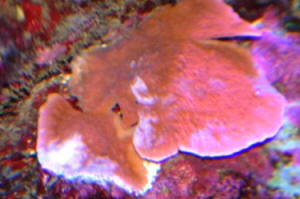
|
|
Brown Jelly Euphyllia paradivisa... actually chem.
starvation, allelopathy... iatrogenic errors 3/16/16
Good Evening,
<And you>
I am looking for your wisdom on saving a large neon Euphyllia paradivisa
from the dreaded brown jelly disease.
This event is spreading quickly so please advise and I will jump into
action.
<Likely expedient>
150 gallon, 6 year established mixed reef, skimmer, LifeReef CO2 reactor
& sump & refugium, LEDs, MP 40s, constant pH 8.06 (due to CO2 reactor?),
<Maybe... What is your RedOx? >
CO2 reactor pH 6.5, no phosphates, no nitrates,
<... all photosynthetic; make that all life requires some measurable
HPO4, NO3... See, as in READ on WWM re>
415 calcium, alkalinity 12 dKH,
magnesium 1300, 1.026 salinity, 80.8 degrees F, 20% water changes
weekly, softies, few SPS, many LPS, 10 fish, hermits, starfish,
snails...
I noticed a small Aiptasia on the disc of a large toadstool leather a
month ago.
<So; in addition to chemical/food starvation, allelopathy may be an
issue>
Yes, I should have addressed it but didn't.
This Sunday, I used a small dab of Aiptasia X on the anemone and noticed
a ring of dead/loose tissue the size of a quarter around the pest.
So I turkey basted up the dead tissue and the melted anemone. When I did
this it revealed a deep tunnel of dead tissue coming from inside the
trunk of the
toadstool. Anyhow, I turkey basted up more dead tissue and then...
proceeded to gently turkey baste the new tunnel through the
toadstool...when
I did this dead tissue spewed into the water column. I turned on the
media reactor
<... what is in this reactor?>
to run carbon and did the 25% water change. Everything looked great in
tank.
Monday, toadstool was still in good recovery.
Tuesday, toadstool looking still positively recovering-the tissue looks
good! Polyps are thinking about opening under the normal shiny slime
coat it gets when it goes through growth spurt. HOWEVER, on the other
side of the 150 gallon tank, I noticed a tiny spot of brown goo on a
hard to see area of a giant Euphyllia, around noon. Hoping it was waste
product, I made a mental note.
At 5:00 p.m., the pea sized brown goo was quarter sized. I rotated the
coral to take a photo and have a clearer view. Yes, it has to be tissue
from the toadstool on the opposite end of the tank landed in the far end
of the frogspawn! What do I do?
<Water changes, chemical filtrant (Polyfilter, GAC) use, and overdosing
of iodide-ate>
This is my prized (6 years with me) neon wall frogspawn. I can't loose
it.
<Or lose it>
Panic is setting in! I have searched the internet and wet web....
Do I try the iodine dipping routine?
<Not dipping, addition>
(I tried this years ago to no avail.)
Do I take it to the LFS with a coral saw to separate infected from good?
(I think this is the only option to save part of this LPS. ?)
<A possibility... but not what I'd do... see the above, use the search
tool (on every page on WWM) and READ>
By tomorrow morning, this could be really bad.
Thanks for any suggestions.
I have learned a painful lesson: turn off power heads when working
around suspicious coral tissue and address pest anemones ASAP.
Sincerely,
Wendy
<And you; Bob Fenner>
|
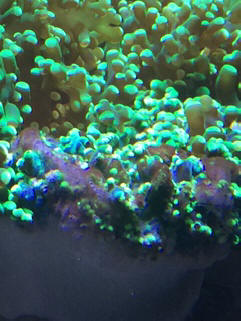
|
|
Euphyllia Brown Jelly
3/16/16
another pic of brown jelly
<This looks more like BGA... do you have a microscope? Same response
otherwise. BobF>
|
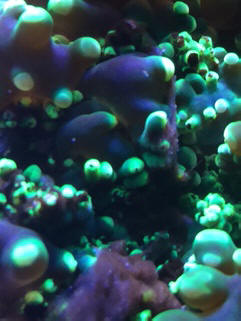 |
|
Toadstool Leather dead tissue
3/16/16
Continued:
Here is a picture of the toadstool with the dead tissue and melted Aiptasia
before I turkey basted up the majority of dead tissue.
The tissue was powdery & fibrous grey. The tissue on the toadstool was not
slimy brown.
But it has to be what started the brown jelly on the frogspawn. ?
<A contributing factor very likely>
Thanks again.
<Allelopathy by Alcyonaceans.... reading. B>
|
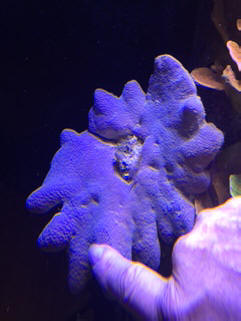
|
Euphyllia Brown Jelly-cautiously optimistic
3/18/16
Hello Bob,
Thank you for your advice! I am cautiously optimistic.
When you mentioned RedOx, I was reminded to learn more about this measurement.
<A VERY useful indicator of a system's capacity to foster life>
Reading through the articles in WetWeb helped me understand its importance. It
will be the next addition to the system.
I did a 25% water change, changed the carbon, changed the poly filter material,
cranked up the skimmer, gently turkey baste away any brown jelly that forms
every couple hours, raised the iodide-ate to .09 overnight, the next morning 20%
water change, more turkey baste removal, iodine level now at .08 and the
frogspawn is looking pretty good!
<In the photo; I agree>
(Tomorrow I will do a 10% water change and work on getting the iodine down to
.07.) The brown jelly production is now minimal and the other 3/4's of the
frogspawn is acting almost normal.
<Great>
(The only coral objecting to the high iodine level is a sunset encrusting
Montipora, other Montiporas are looking fine.)
I have been reading and will continue to read about increasing nitrates and
phosphates. So the goal is NO3 a few ppm and HPO4 between .01-.05?
<Yes>
I looked back into the log, and Nitrates ranged between 0 - .2 (Salifert), and
Phosphates ranged between 0 - .04 (Hanna & Red Sea) over the past 6 months. Most
of the time the readings were 0, which is strange when the
refugium is full of macroalgae,
<Ah, not strange... the algae are/were scavenging most all>
fish are generously fed, I target feed corals, corals are growing, and
occasionally tank has a minor hair algae event.
<I'd remove a good deal of the 'fuge macro-algae... only run the 'fuge lighting
at night; in opposition to the main/displays>
A Neptune Apex was recently installed, so the next programming I will do is to
turn off the skimmer during feeding...and night?
<I'd leave running at night; for DO>
and add the ORP probe.
Anyhow, thank you for the recommendations and hopefully this wall Euphyllia will
pull through. I feel that it was in a thriving state of health before this event
due to its tripling in size over the past 6 years, great polyp extension and
good fleshy tissue around the calcified base.
Reading, reading, reading is the only way I have gotten this far in the
hobby...the chemistry part isn't natural for this art major. Thank you for
trusted advice.
Sincerely,
Wendy
<Your response, success... is exactly what I hope for in producing and making
WWM available. Thank you for sharing.
Bob Fenner>
|
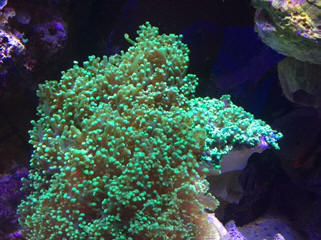
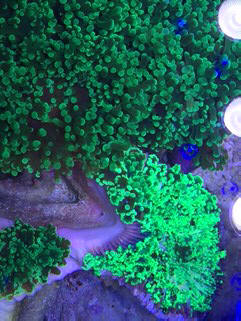 |
|
|
brown jelly disease
3/7/14
To whomever this may concern,
I am currently dealing with brown jelly disease. It wiped out my small
hammer and much of my abundant frogspawn. I am nearly positive that is
what it is, because I literally saw multiple heads melt away
into a brown goo and half my coral was gone in a day and a half (i have
tons of frogspawn in my tank). Water parameters were good
(alkalinity was lower than I would like at 8.0 but I started dosing
afterwards), but I used my remaining mixed water to do a large water
change following the removal of the affected corals. I am not sure how
this "parasite" got in my tank since I haven't added anything in a long
time, but I am guessing my corals were susceptible because they are so
big now that they come out of the water during water changes and a bit
of the coral flesh tears on the sharp skeleton as it hangs for a few
minutes.
<Mmm; well; this symptom has an unknown etiology (causative
mechanism)...
Is there a principal organism; ciliates, bacteria, involved directly?...
Do read here re:
http://aquariumcoraldiseases.weebly.com/brown-jelly-syndrome-bjs.html>
Anyways, I now have like 4 small colonies of frogspawn left ( I
completely scrapped 3, including my largest one in hopes of saving the
rest) and none of the have melting heads or brownish jelly. Two of
the colonies seem to be receding a bit at the base and have some
encrusted ulcerating lesions around parts of the base. Attached is a
picture of one of them that happens to be close to the glass; you can
see the fleshy part is receding at the base and there are these
ulcerating lesions on it. I am paranoid that this is somehow related to
the brown jelly issue and am wondering what I should do since it is the
base of the coral being affected and I don't exactly have mixed water at
the moment to do any sort of Lugol's dips with (mixing more tomorrow).
in the meantime, I am keeping water quality in tip top shape and am
testing Ph, temperature, alkalinity, calcium, and salinity daily and
nitrates every few days. Any impressions or advice on whats going on
with these lesions would be greatly appreciated. Thank you for your time
and help, it is very appreciated.
Sincerely,
Gabby N
<Likely the stock Metronidazole treatment is a good move. Bob Fenner>
|
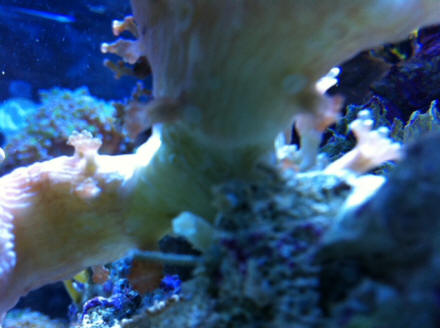 |
|
White spots on Montipora capricornis: RTN\Brown Jelly
Disease. 4/9/2010
Hello!
<Hi Tom.>
I have attached an image of my orange Montipora capricornis.
<I had one similar, as well as a purple rimmed
variety.>
It has been doing wonderfully since I got it a few months ago,
and has grown to about 6 times the original size.
<Mine were growing well also.>
In the past 2 or 3 days, it has begun to develop white spots on
it that are spreading fairly rapidly and now appearing in other
locations on its top surface.
<Same thing that happened to mine. It isn't bleaching,
that is tissue death\Brown Jelly Disease.>
I have inspected for Nudibranchs but have found none.
<Not Nudibranchs.>
This is the only coral in the tank that appears to be having any
kind of problem.
<All of my LPS and Softies were not affected.>
All other SPS, LPS and soft corals are doing very well. Even two
Goniopora have been rapidly growing for over 3 years. (Funny... I
refused to buy them at the LFS, but a co-worker persisted so I
reluctantly agreed as long as they paid for them. Its now years
later and they are at least 10 times the size and have encrusted
onto multiple other rocks. No idea why, but I have had great luck
with these, but back to the matter at hand...)
<Congratulations, Goniopora are not easily kept.>
The tank is 135g with 40g refugium/sump.
Fish load is light. 3 damsels, 1 Blue tang (4"), 1 Scopas
tang (3"), 1 Banded Cardinalfish,
1 Watchman goby, 1 Blue-spotted blenny, 1 Ocellaris clownfish, 1
Six-line wrasse.
<No culprit there>
I do 25% water changes monthly like its a religion (last change
was exactly two weeks ago), and I run 3 bags of charcoal in
direct flow in my refugium to combat allelopathy, changing one at
a time. Skimmer is an AquaC EV120 that skims about a gallon of
skimmate a week. Also running is a phosphate reactor. I grow and
harvest Chaeto in the refugium.
<All sounds good there as well.>
In short, everything is going wonderfully beyond my wildest
dreams. And now this problem just popped up in this one
coral.
<This took out a large number of Montis in my local reef
club>
Do you think that it is a Nudibranch infestation that I'm not
seeing?
<No.>
The only other thing I can think of is that its close to time to
change my bulbs.
I run two 250w MH lights and change the bulbs every year.
Its been a year and a week. Would such a rapid development of
these white spots seem like it would be caused by
old bulbs?
<No, Old bulbs or the wrong light would show bleaching all
over, not in spots. and you would see a reaction in your other
corals as well.>
Please let me know if you would like any more info from me.
<Water parameters are always helpful. However, if everything
else is going well, I'm sure yours would not reveal any
'smoking guns'. >
<Do read here: http://www.wetwebmedia.com/corldisart.html
and do a google search on the site for Brown Jelly Disease.
This 'disease' kills and it kills quickly. It seems to
start by a small, insignificant injury and spreads rapidly from
there. As it spreads, you will start to see a brown or tan goo
floating above the coral. I was able to save a piece of each of
my colony by fragging a healthy part of the coral furthest away
from the infection and keeping it in another tank. You can try
sucking up the goo with a turkey baster and getting it out of
your system. Unfortunately, it did not work for me. I also tried
applying a dilute Lugol's solution directly on the coral
using a pipette. About the only thing I did not try, as it was
impractical, was removing he rock the coral was attached to a
hospital tank and treating with antibiotics, though that could
kill the coral just as quickly as the disease can.>
I appreciate the work you guys do there immensely, and I can
certainly say that the point when I found wetwebmedia.com was the
turning point in the hobby for me.
Thank you for being you.
<Thank you for the kind words and the best of luck in treating
this.>
-Tom
<MikeV>
|
 |
|
Brown jelly disease? Mmm, no
12/22/09
Hello WWM,
I've had a problem with my reef tank that just won't go
away and I'm in need of expert help. About two months ago my
Hydnophora developed a quarter-sized, brown slime patch. I
assumed Cyano, cleaned off the coral
and dipped it in some iodine based coral dip. It returned fully
about two weeks later and that's when I noticed some brown
stringy material on some other corals as well. It progressively
got worse to the point of covering
other SPS corals in the tank. Not big slime patches but many
individual strings of the slime. I proceeded by syphoning off the
strings daily and performing 10% bi-weekly water changes on top
of the two gallons being
replaced daily from the syphoning. Everyday the same corals had
the strings in the same place so I'm assuming it's the
individual coral making it.
<I wouldn't make this assumption>
After a couple weeks of constant cleaning it was almost gone but
now it's starting to return. Also, sometimes the strings will
be on my Halimeda plants and on the rocks and sometimes they have
little air bubbles in them.
The strings just seem to breakup like slime not with substance
like a plant. Could it be Dinoflagellates?
<Highly unlikely. Do you have a microscope?>
Could it be STN/RTN with Cyano attaching?
<Likely just the latter... what re net causes here?>
I'm lost and at the end of my rope. Please help!
<Umm... water quality test results?>
My system: 125 gallon reef mostly SPS, refugium with Gracilaria,
large Octopus skimmer, GFO reactor, 630 watts T5 lighting, 4
Koralia powerheads, live rock wall, community fish. The GFO
reactor
<Whose, what media are you running in this?>
was installed about a month prior to the problem
<I would turn this device off, take it off-line... your corals
need some soluble inorganic phosphate>
and the T5 lights changed at the same time. If I missed anything
or for more info on my system and pics you can see my reef club
site post here:
http://www.thescmas.com/forums/showthread.php?t=5433<http://www.thescmas.com/forums/showthread.php?t=5433
Thanks JLaurence.
<"Looks" like BGA... again, there is either some
sort of nutrient imbalance or an essential nutrient limitation
going on here likely... Remove the reactor, look to other means
of control. Read here:
http://wetwebmedia.com/bluegralgae.htm
and the linked files above. Bob Fenner>
|
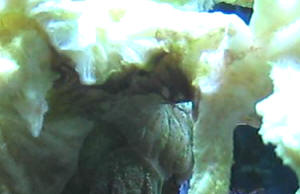 |
Possible cause of death for torch?? 6/9/08 Hello,
<Hello> I have a question about a torch coral I had. It was about
three inches across and looked great. I got it from a good LFS and it
was packaged upside down in foam in the bag. <Good packing> I set
it on a rock midway up in my tank. It got brown jelly on one head the
second day in my tank so I cut the infected head off and gave it a
fresh water dip. <Removing the infected head was good, provided no
tissue damage occurred as collateral to the other heads. Freshwater
dips can be hard on corals, I'm a fan of iodine solutions myself.
Opinions vary.> I placed it back in the tank and then next day it
was brown jelly all over (the other 2 heads). I removed it but it did
not make it. <Unfortunate, but it does happen. Not much you could do
about it.> It looked healthy and fully extended at the store and the
first day in my tank. They had many great looking torches. When I was
placing it I may have rubbed some of the polyps lightly against the
rock. Could this have been enough to start the brown jelly?
<Probably not. Most likely stress of moving, something in the tank
water. How did you acclimate this coral?> I want to get more
Euphyllids but don't want them to die. I also got a rock with
several large frilly mushrooms at the same time and they are doing
great. The torch was at least 10 inches from any other coral , probably
more. I have put a lot of thought into the occurrence and my best
theory is that I damaged some of the tissue when placing the coral and
this allowed the dreaded brown jelly to start. This was my first LPS
but I would like to get many more. Any thoughts would be much
appreciated. Thanks for the help and all your help in the past.
<Jeff, I would use/purchase a nitrate test kit. It is possible you
have higher nitrate in your tank, which would foster/cause/aid brown
jelly and other pathogenic organisms. If you do a test and this is the
case, consider more frequent water changes. Otherwise I would say try
again, and unless this becomes a trend fear not...an unfortunate
coincidence that your first LPS had this problem.> Jeff tank: 72
gallon bow front 20 gallon sump with 5 gallon section a refugium 80 lbs
live rock 80 LPS aragonite fine sand 2 10,000k 65 watt pc 2 420nm
actinic 65 watt pc ph=8.4 ammonia=0 dKH=11 ca=500, should this come
down to 450? <Or 400> 5 to 10 gallon water change every 2 to 3
weeks - does not seem to lower ca <I would recommend a 10% total
volume water change weekly to maintain water chemistry, clean
water.> frilly mushroom rock yellow sea blade - grows like crazy
pink pulsing xenia on a small island in the sand Scopas tang pink spot
goby scoter blenny long nose hawk fish three stripe damsel, mean and to
fast to remove scarlet skunk cleaner - he just started cleaning the
tang after about 1.5 months in the tank, finally various snails and
hermits for cleanup <Sorry to hear about your torch, better luck
next time! Benjamin>
Brown Jelly Disease -03/17/08 Hi, I have a couple
of questions.. I do believe my one frog spawn has brown jelly disease..
Should this be removed from the tank and quarantined? <It depends on
how bad it is. Moving it now might make things worse. If it's
progressing rapidly, your only hope might be to frag off the infected
parts.> Does this disease spread to other corals? <Yes and no,
it's a complicated question actually. Think of this disease as an
infection a bit like one a person might get from a dirty wound. The
infectious agents can spread, but usually won't infect an otherwise
strong, healthy coral.> And last but not least how can I go about
curing this disease.. <There's unfortunately not much you can do
except perhaps gently siphoning off the "jelly", increasing
water flow to the coral, and generally making sure your water
parameters are as ideal as possible. Running some activated coral and
increased skimming might also help. Again, if it's bad enough, you
should consider immediately fragging off the infected parts.> Thanks
Trish <De nada, Sara M.>
Brown Jelly 12/25/06 Hello, and merry
Christmas. I recently had a brown jelly infection on a
Goniastrea brain coral which I moved to a separate tank and cleaned the
coral regularly. It seems to be gone although much of the
coral seems to have died or possibly just receded and may come
back. My question is how contagious is brown jelly disease
as I am worried about other corals "catching" the
disease? <Is a good question... there are instances
I'm aware of where both situations... isolation and spread
occurred... the etiology of this "condition" is not entirely
understood> I recently added a Acropora Tortuosa which today I
noticed had some "goo" stretching between polyps in a couple
of areas. Rather that worry about what it was I decided just
to break that part of the coral off to prevent it from spreading
anywhere else on the coral. <Good idea... This is what I would have
done at least> The coral was is rather small anyway and it
wasn't all that expensive, so I'd rather just dump it than
worry about spreading infections. Can all corals get
brown jelly infections or is it mainly just the LPS corals? <All
can... larger polyped species seem more susceptible> My water
quality is good and all other corals are healthy. Water
parameters are: ammonia 0, nitrite 0, nitrate 5, alk 10.6 Dkh, calcium
400, Ph 8.3, salinity 1.024, temp. 78. I have been doing a
ton of reading about brown jelly infections and even wrote Eric
Borneman regarding the brain coral and followed his
recommendations. My main concern is the infection spreading
throughout my tank, does brown jelly mainly attack corals that are
unhealthy? <The latter> Sorry this email was a little scatter
brained, I am a little freaked out about this spreading as I would lose
a lot of corals and the money I paid for them. Thanks, Ryan
Nienhuis. <Thank you for sharing. Bob Fenner>
Rapidly dying torch coral 3/17/06 Hello and I
appreciate your help very much. Over the period of one night
my torch coral appears to have lost over half of its heads and instead
there is a brown filmy material there. Should I break off
the rest of the coral that appears to be doing good or is it possible
that these heads will reappear magically? We added a
wavemaker to the tank the other day, but it was turned off over night
during this decline. Could this be the reason for this
loss? My roommate, however believes that the coral has just
retracted to eat since he fed them yesterday. That is the
only major change to the tank. What is your advice or
opinion? <<This is "brown jelly"
disease. The affected heads should be removed
immediately. You may even want to siphon the dead tissue
away before moving the colony. I would also suggest adding
some carbon to the system if possible. The unaffected heads
may be OK and removing the affected ones will definitely
help. Best Regards. AdamC.>>
Brown jelly disease 1/13/06 Hello
there, <Howdy> First of all I would like to apologize for the bad
grammar, English is not my strongest language, unfortunately it's
the only one I know. <Heeee! A useful practice to use computer tools
like spelling, grammar checkers...> Seems our reef tank has been
infested with brown jelly disease. We moved the contents of
a 36 gallon into a 90 gallon about a month ago. We also
incorporated a sump and refugium into the system. Moved 70+ lbs. of LR
and added another 30 lbs to the main tank. I thought I had damaged some
of the mushrooms in the re-arranging of the rock. A few of the
mushrooms turned to a gel and slowly disappeared. All of the mushrooms
were not affected and the situation seemed to have cleared up. We also
have yellow polyps, torch coral and a pink coral that I do not know the
name of. One of the branches on the torch coral suddenly turned into a
brown ball of slime in just a short time, a few hours. Then another
branch on the torch started to do the same thing. With just one branch
left I had a panic attack and sent you that awful e-mail. After doing a
little more research, I removed the torch coral by placing it in a
plastic Ziploc bag. I broke off the infected branches of the coral and
placed them in a cup of freshwater. I then took another glass of fresh
water and added ten drops of iodine to the water. <Good... would add
Lugol's to the tank as well> I placed the torch coral that was
still alive in the solution for a few minutes. After removing the coral
I placed it back in the main tank, since a QT tank is not set up. I
then placed a power head so that it blows directly onto the torch
coral. The dip seems to have helped the coral, the brown slime that was
on it turned white and washed off in the solution. The water flow over
the coral seems to be keeping the coral from building up brown slime,
however it does not look healthy at all. I may dip the torch coral
again tonight , to remove any irritant that may still be on it. I have
read that the tank may be treated with vitamin C to cure the ailment. I
could not find any information on just how the tank should be treated.
<I would not just add ascorbic acid here... You can add a vitamin
complex... commercially made or no... but would soak foods in it
instead of directly applying> Any help on this matter would be
greatly appreciated, thanks for having this great website and helping
so many people such as myself, and being sucha gooder enlgish
teecher.:) Peter <Restore stable conditions to this system, add the
Lugol's... and consider fragging, removing the bad branches of the
Torch if this seems prudent in a few weeks. Bob Fenner>
Brown Jelly and Hawkfish 7/28/05 Hello,
<Hello, Mike G with you tonight.> How are today?
<Good. Big storm's coming this way. Doing my part to answer a
few queries before the power goes out.> Well, I have two quick
questions today. First, I have a torch with about twelve heads on it,
and one is closed up and a brown mucus is forming on it.
<Yikes. It's called "Brown Jelly." Brown Jelly is a
bacterial infestation of many species that often takes the lives of its
victims. To halt it, you could try first gently siphoning as much of
the "jelly" as you possibly can. Next, remove the coral from
its tank and treat it with an Iodine solution. Lugol's Solution is
said to work in this instance. Return the coral to the main tank. Keep
your water quality up, a water change could not hurt at this point.
Repeat if necessary.> I have never seen this before, and wondered
what to do? <See above.> Second, is it aggravating
for corals if a hawk fish sits on them frequently?
<Yes.> Thanks for the help. <You're very welcome. Good
luck with the jelly. Mike G>
Brown Jelly infection on Gonio I think that my Goni might
have brown jelly disease, there is a kind of orange film
developing on some of the polyps, how do I get rid of this infectious
disease and save my Gonio? <this secondary barrage of infectious
pathogens known as "Brown Jelly" is highly infectious and so
virulent that odds are not good at all of saving the specimen. You will
be lucky if it doesn't kill other corals in the tank too (healthy
established ones too!). This is just one of the many reasons why it is
so critical to quarantine all livestock for a full 4 weeks before
adding them to a display. Besides having a better chance to save the
new guy, there is always the risk of infecting some/all of the
established animals. My advice is to capture this coral underwater with
a large plastic bowl and lid (the coral is to be moved slowly and
sealed in the bowl underwater) to reduce the chance of drifting
infected tissue through the water. If any pieces do float away...
siphon them out promptly... it is highly infectious to other corals.
Treatments to date are highly experimental with antibiotics, FW dips
and iodine spikes. I honestly don't think the coral will be alive
48 hours from now, I hate to say, but do consult Eric Borneman's
Aquarium Corals book for an extensive range of options. My advice is a
60 second shower under cold tap water (seriously) before placing it in
QT. Maintain vigorous circulation and aeration in QT as well. Best
regards, Anthony>
Goniopora and brown jelly (protozoan) infection? Hey Anthony,
The good thing is that I don't have any other corals in my tank,
<a good thing> I was coaxed into buying this Goni as my first
coral by my local LFS. <wow... if they are receptive, willing to
learn... please suggest that they browse and use our free
resource/database for themselves and their customers. Promoting success
in the hobby is out mutual goal. Also suggest that they buy either of
Eric Borneman's coral books for a quick reference to not make such
a terrible mistake again> My coral doesn't have much brown jelly
on it and I am thinking that it might just be decay of the slowly dying
coral. <agreed... simply decay. "Brown Jelly" is wickedly
virulent... you can literally watch flesh fall away over a period of
hours.> Thanks for all the help involving my Goni. <best regards,
Anthony>
"Brown Jelly", Or Just An Orange Spot? (ID'ing
Coral Disease) Hello! <Hi there! Scott F. with you today> I
have a hammer coral that has an orange circular 1/4 inch
spot on the stalk of the coral about an inch down from where the where
the polyps start to extend from the stalk. From everything I have read
about brown jelly, it sounds like brown jelly develops on the polyps
themselves. <Well, this condition can develop throughout the animal.
It is thought to be initiated by a trauma to the coral...and, of
course, coral can be injured anywhere on the animal...> This spot
seem to be very solid. Is it possible for brown jelly to developed on
the stalk. The fact is that I don't know if this is really brown
jelly or not. How can I be sure? I might have to send you a photo.
Please let me know what you think? -Ron <Well, Ron- it is thought to
tell from here; even with a photo, it may be difficult to get a
positive ID. However, you can make a reasonably good
"diagnosis" by looking at the nature of the tissue damage on
the coral. "Brown Jelly" disease is typically a mix of dead
tissue and microorganisms, and has a definite "jelly like"
appearance...Not the greatest diagnosis aid, I know, but if it looks
like "brown jelly", it probably is "brown jelly"!
:( Sounds like what you're seeing might be something
else...possibly not even dangerous...Keep observing, and take action if
necessary...Regards, Scott F>
Battling Brown Jelly Hello, <Hey, Mike G
with you this afternoon.> I have a frogspawn frag, and in about a 24
hour span it has closed up completely. This is very unusual for this
coral. As of this morning, the coral looks ragged, and has what appears
to be a hunk of brownish dead tissue hanging from it. <Ouch.> Is
this the dreaded brown jelly disease? <Sounds like it.> What is
my best option for treating it? Thank you. <Brown jelly is a pretty
vicious disease, and takes many corals as its victims. To halt it, you
could try first gently siphoning as much of the "jelly" as
you possibly can. Next, remove the coral from its tank and treat it
with an Iodine solution. Lugol's Solution is said to work in this
instance. Return the coral to the main tank. Keep your water quality
up, a water change could not hurt at this point. Repeat if necessary.
Hope this helps.>
Frogspawn Coral w/Brown Jelly? While I awaited
your response, the condition only seemed to worsen. So I went ahead and
did a freshwater dip and siphoned/pulled some of the brown mess
away. <A freshwater dip for coral is not a good idea
Eric.> It was definitely dead tissue as it smelled quite bad.
Now almost a day removed, there seems to be no more of the jelly,
however one polyp is down to the white skeleton, while the other large
head doesn't seem as bad. The really new/small polyps seem
unharmed. Now to my question (sorry for the length). Do you think that
my other corals are safe at this point or should I take further action.
Other corals include a torch, xenia, star polyps, button polyps. Thank
you for all of your help. <The others should be safe as long
as they are healthy. I'm thinking about your flow rate...do you
have at least 10x total water flow in your system? We want our corals
to be constantly bathed/washed if you will. James (Salty
Dog)>
Open Brain Sliming Good Morning! <It's
evening! Trying to trick me, eh...> I purchased a green/red open
brain a couple of weeks ago. It looked good, has expanded more in my
tank than in the LFS, but yesterday morning I noticed a bit of a
translucent slime around one edge. This morning it had extended to
enshroud approx. ½ the coral. There is a bit of skeleton exposed on
the edge that first exhibited the problem. The edge where this started
is up against some live rock (wasnt touching when I placed the coral,
but it has since expanded and now touches a bit is that a problem???)
<I would not allow the extended tissues to touch the rock, as it
will become abraded in the extensions and contractions these animals
perform day to day> Is there anything I should be doing other
than wait and watch? Tank params: 52 g 20 in. tall Lighting: 2-
96w PC actinics, 2- 175W 20000k MH Ca/Alk: 405/2.9 Temp: 78 78.5 pH:
8.2 NO2/NO3 both 0 <If
you have a coral of the genus 'Trachyphyllia' then the
"sliming" behavior is perfectly natural. These corals excrete
a mucus coating to trap floating particulates, and then ingest the
entire coating. Make sure you keep it well fed - M.
Maddox>
Re: Open Brain Sliming - Brown Jelly Disease
Well, it turned out to be brown jelly. By this afternoon there was very
little living tissue left - probably 2/3 of the skeleton was fully
exposed and what little live tissue was left was breaking down and
melting away. <Ack! Remove that coral ASAP! It may be possible to
frag and save the healthy parts of the coral, but you do NOT want the
'brown jelly' (a protozoan) spreading!> Are any of the
following organisms at risk from loose "jelly" being blown
around in the tank (GSPs, mushrooms, hammer coral, trumpet coral, pearl
bubble coral)? If so, is there anything I can do to lessen the risk?
<All LPS are at risk - remove the coral ASAP. If you don't have
a QT tank, just ditch the entire coral> I've started running
charcoal - don't know if that will help, but I guess it
couldn't hurt... <Never a bad thing, but it won't kill
protozoans. Make sure to remove it ASAP, and keep a very close eye on
your other LPS. In the meantime, set up a quarantine tank if you
don't already have one!> Thanks, -Brian <Good luck - M.
Maddox>
Re: Open Brain sliming & Brown Jelly Disease
Follow-up I took it out a few hours after my last post - there was
no healthy tissue left, but some of that stuff did get loose in the
tank, some when I was removing it and some due to my peppermint shrimp
slicing and dicing at it, so ... <Too bad :\ Quarantine next
time!> I found an article that suggested as a follow up to dealing
with an infection adding Vitamin C to the tank for 14 days according to
some instructions but the link to said instructions was dead - how do I
do this? How much and what form? Ground up C from the health food
store?? An additional recommendation was good flow to reduce the
chances of the jelly being able to collect, which I have. <Do not
add ascorbic acid directly (i.e. don't use human pills) as it will
drop your pH drastically. Instead, use a liquid\buffered supplement
that can be found on any online retailer's site> Thanks, Brian.
<Anytime - M. Maddox>
Coral meltdown Hi there, a good friend of mine has a nasty
problem. In about 24 hours a huge frogspawn melted down to
the skeleton, forming this brown goo that smells like death (brown
jelly disease?). All hammers and frogspawn in the tank seem
to be affected to some degree (there are about 5-6 of them), the brains
and Blastomussa as well as a couple of softies seem ok for
now. Corals were dipped in Tech-D last night and will be
freshwater dipped today. He put in additional skimming,
carbon and a PolyFilter. We're looking for advice on how
to avoid a total meltdown. Thanks Stephen <Besides what you've
done....water changes, water changes, water changes. Like
10-25% a day. I wouldn't do anymore stressful
treatments. Test water parameters and make sure they are
within the norm. Also watch temp...this is most likely environmental.
QT all new corals. Best of luck! Craig>
Coral Meltdown redux <Hi Steven, I looked into this
further (in Anthony Calfo's great book!) and he advises removing
all infected corals from the display in a plastic container, then
removing any infected, dead and necrotic tissue with a stream of water
and then with a toothbrush down to healthy tissue, then placement in a
QT tank, perhaps with iodine/Lugol's in known doses. As
a last resort fragging/separation of healthy tissue from infected.
Discard all operation/rinse/cleaning water and lift corals from display
in container to prevent stress and contamination. Iodine may be used as
a dip and in the working containers. Time is of the essence. Good luck,
Craig>
Brown Jelly and Hammer Coral I have lost the last three
hammer corals I purchased. Each lasted approx. 4 weeks. They all
succumb to brown jelly infection. All my other LPS corals are doing
well i.e. frogspawn, torch, Candycane. Have you experienced this or
heard of this problem as of late? I am wondering if it from collection
methods etc. The so called hardy hammer may be coming more like the so
called hardy elegance. <Yes... not an uncommon occurrence. Please
read through here: http://www.wetwebmedia.com/caryfCorlsaqs.htm re what
folks in the trade do for preventing this largely bacterial complaint.
Antibiotic and dilute seawater dips... Bob Fenner> Any help greatly
appreciated. Mario
|
|

